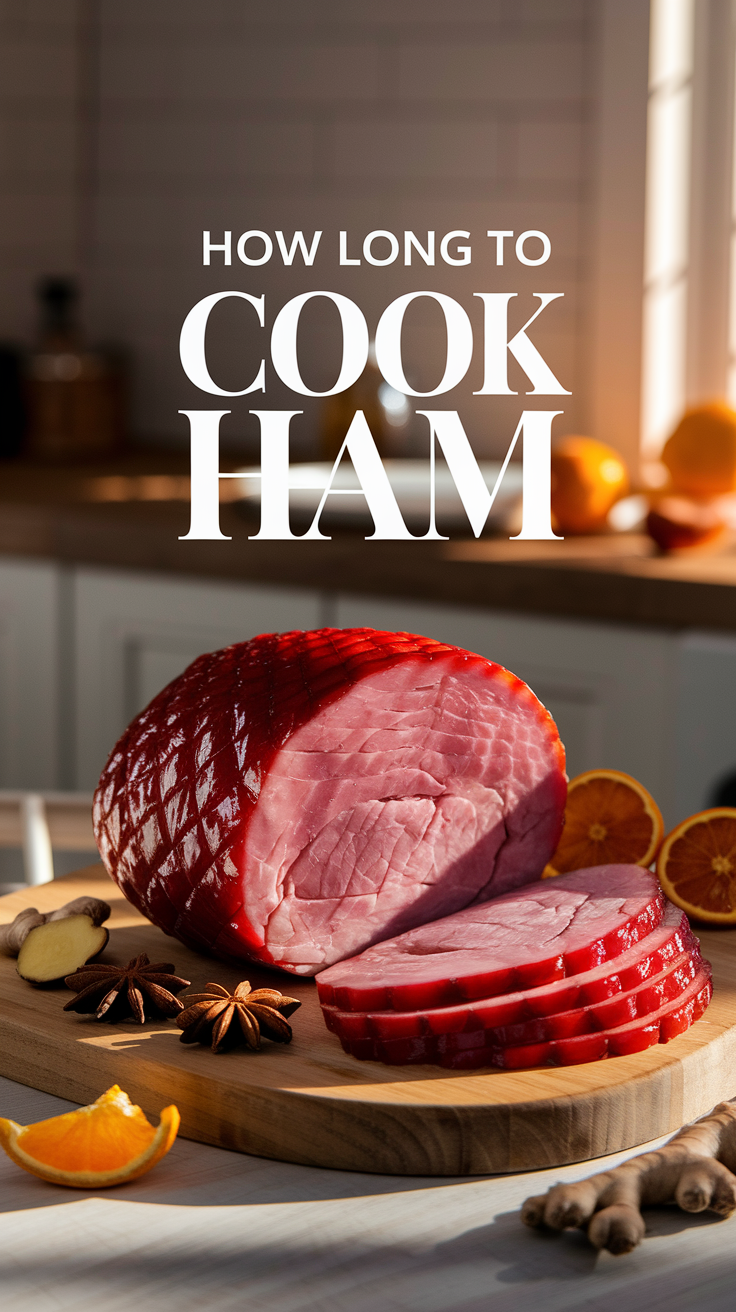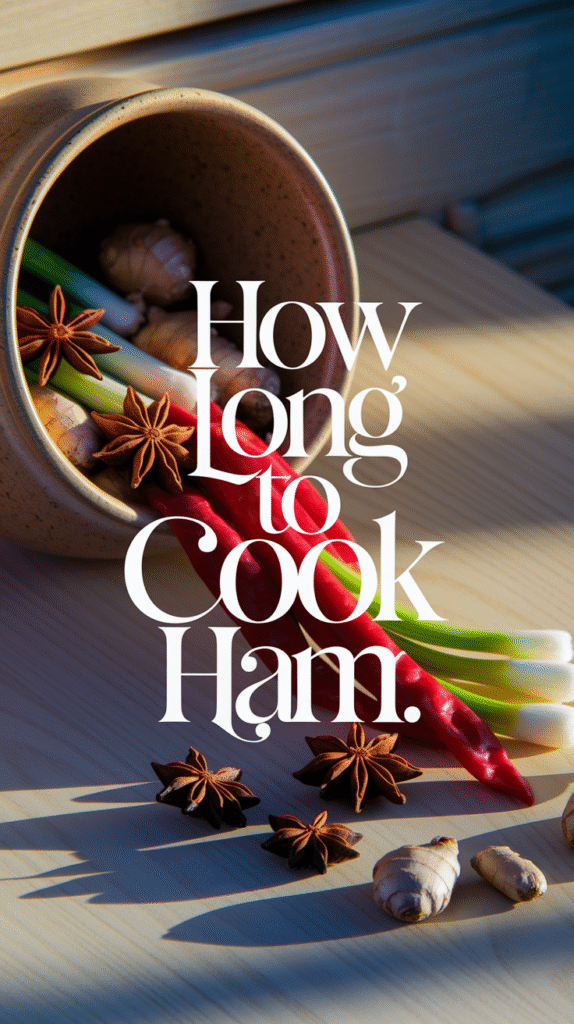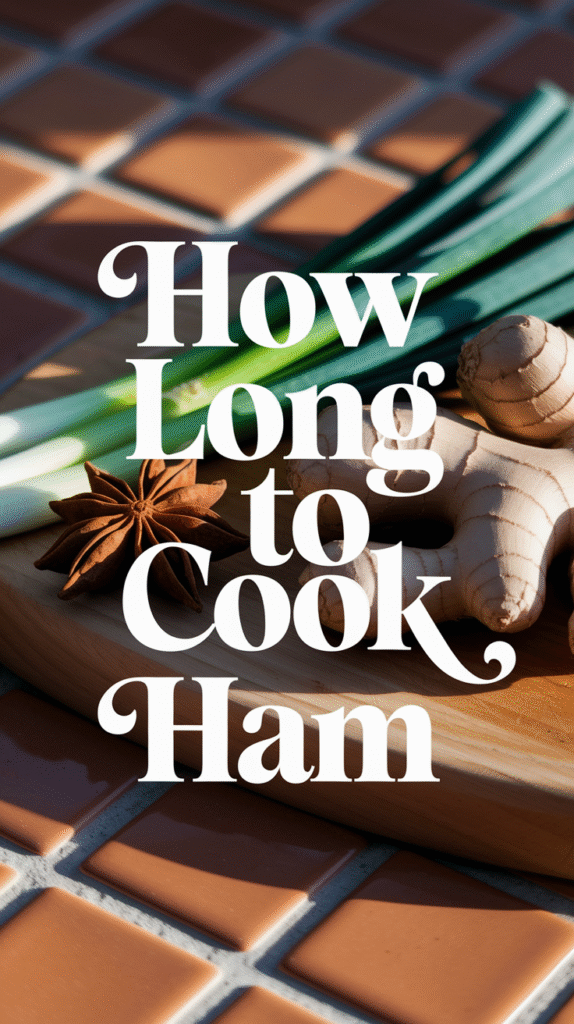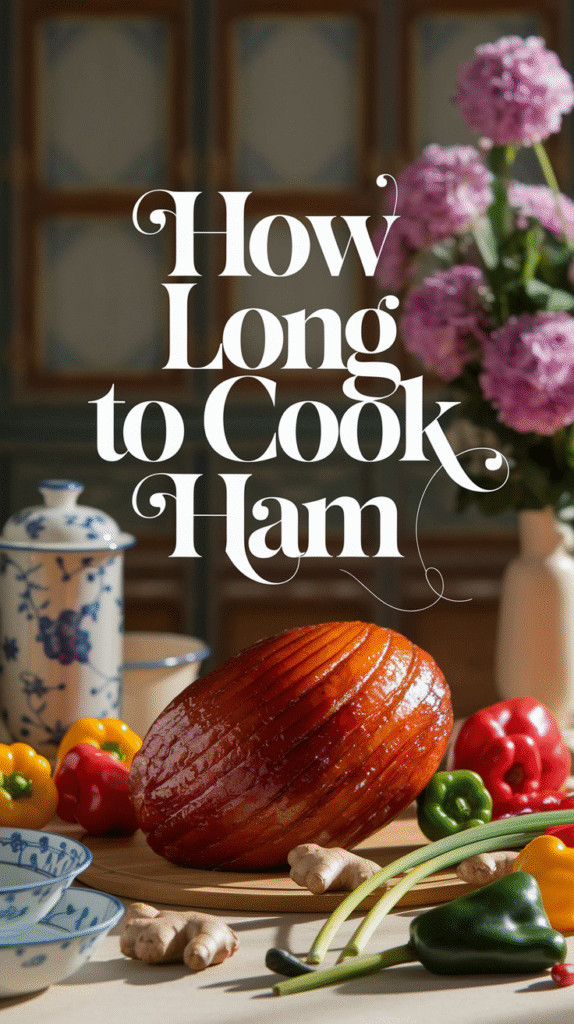Cooking ham can seem daunting, especially if you’re unsure how long to cook it properly. The time needed depends on several factors, including the type of ham, its weight, and the cooking method. By understanding these factors, you can ensure your ham comes out perfectly every time.
Types of Ham
Different types of ham require different cooking times. Here are some common types:
- Fully Cooked Ham: This type has already been heated to 140°F (60°C). It just needs reheating, typically taking less time.
- Partially Cooked Ham: These hams require cooking and must reach an internal temperature of 160°F (71°C). They need more time than fully cooked options.
- Raw Ham: This type should reach an internal temperature of 145°F (63°C), with an additional rest time of at least three minutes.
Weight Matters
The weight of the ham plays a crucial role in determining how long to cook it. As a general rule:
| Type of Ham | Cooking Time per Pound |
|---|---|
| Fully Cooked Ham | 10 to 15 minutes |
| Partially Cooked Ham | 18 to 20 minutes |
| Raw Ham | 20 to 25 minutes |
For example, if you have a seven-pound fully cooked ham, you should plan for about 70 to 105 minutes of reheating. You should always use a meat thermometer to check the internal temperature.
Cooking Methods
The method you choose also affects cooking time. Here are common cooking methods:
- Oven Roasting: This is the most popular way to cook a ham. Preheat your oven to 325°F (163°C) and cover the ham with foil. Bake according to the weight guidelines mentioned above.
- Slow Cooking: For ease, a slow cooker can be used. It requires roughly six to eight hours on low, depending on the size of your ham.
- Grilling: You can grill ham over indirect heat, cooking it until it reaches the desired temperature.
Additional Considerations
When determining how long to cook ham, consider the following:
- Bone-In vs. Boneless: Bone-in hams usually take longer due to the mass of the bone.
- Glazing: If you’re glazing your ham, consider added time. Glaze it in the final 30 minutes of cooking for the best flavor.
- Resting Time: After cooking, let the ham rest for at least 15 to 20 minutes. This helps retain moisture and improves flavor.
Understanding these factors will help you achieve the best results when cooking ham. Keep an eye on the temperature and adjust cooking times based on the weight and type of ham.
For more information and helpful tips about cooking ham and other meats, you can visit FoodSafety.gov or National Hog Farmer.
Now that you know how long to cook ham, your next family gathering or holiday celebration is sure to have a delicious centerpiece. Don’t forget to enjoy and add your favorite sides for a complete meal!
Different Cooking Methods for Ham: Pros and Cons
Cooking ham can be a delightful culinary adventure, especially with various methods available to achieve the perfect dish. Each cooking technique brings out unique flavors and textures, making it essential to understand the pros and cons of each method. Below are some popular cooking methods for ham, along with their respective advantages and disadvantages.
Oven Roasting
Oven roasting is perhaps the most traditional method for cooking ham. It produces a beautifully caramelized exterior and a moist interior, enhancing the flavors of the meat.
- Pros:
- Provides even cooking, allowing the flavors to develop fully.
- Allows for a crispy outer layer that many find appealing.
- Can be easily integrated with glazes for added flavor.
- Cons:
- Takes time and may require several hours depending on the size of the ham.
- Requires attentive monitoring to prevent overcooking.
- Heating the oven can increase energy consumption.
Slow Cooking
Using a slow cooker to prepare ham is an excellent choice for those who wish to set it and forget it. This method allows the meat to soak up flavors over several hours.
- Pros:
- Tenderizes the meat effortlessly, making it juicy and flavorful.
- Perfect for busy schedules – you can prepare it in the morning and have it ready by dinner.
- Less kitchen supervision required due to low cooking temperature.
- Cons:
- May not provide a crisp crust, unless finished in the oven.
- Long cooking times can require advance planning.
- Could lead to a loss of some textures compared to roasting.
Grilling
Grilling is a less conventional method for cooking ham, but it can infuse a wonderful smoky flavor that complements the meat.
- Pros:
- The high heat from the grill creates beautiful grill marks and a smoky taste.
- Can be completed in a relatively short time compared to other methods.
- Great for outdoor gatherings, adding a unique flair to your event.
- Cons:
- Requires careful temperature management to avoid drying out the meat.
- Requires advanced skills to prevent flare-ups and burning.
- Not suitable for large hams without special equipment.
Boiling
While boiling might be the least favored method for cooking ham, it can be suitable for specific recipes or cuts, particularly for ham hocks.
- Pros:
- Retains moisture effectively, ensuring the ham stays juicy.
- Can be combined with various seasonings and vegetables for added flavor.
- Simple and straightforward, suitable for novices.
- Cons:
- Can lead to a less appealing texture, causing the ham to be mushy.
- Flavors may dilute, resulting in a bland taste if not flavored properly.
- Messy cleanup due to splattering water and potential spills.
Pressure Cooking
Pressure cooking ham can save time and deliver tender results. This method is ideal for those who want to speed up cooking.
- Pros:
- Significantly reduces cooking time while maintaining moisture.
- Flavor development is enhanced due to the sealed environment.
- Efficient for smaller hams or portions.
- Cons:
- Requires a pressure cooker, which may not be available to everyone.
- Can be intimidating for beginners unfamiliar with pressure cooking.
- Lacks the opportunity for caramelized textures unless finished separately.
Choosing the right cooking method for your ham ultimately depends on your preferences, time constraints, and the outcome you desire. Read more about specific ham cooking methods at Food Network or discover delicious recipes on AllRecipes.
Understanding Ham Varieties: Which One is Right for Your Meal?
Choosing the right type of ham for your meal can elevate your culinary experience significantly. With various varieties available, understanding their differences will help you make an informed decision. Here, we’ll explore several popular ham varieties, highlighting their unique characteristics and ideal uses.
First, it’s essential to know the two main types of ham: fresh ham and cured ham. Fresh ham is from the hind leg of the pig and is uncured, meaning it has not undergone any preservation process. Cured ham, on the other hand, has been treated with salt, nitrate, or other preservatives. Cured hams come in several specifically categorized types:
- City Ham: This is a wet-cured ham, injected with brine, making it salty and packed with flavor. Popular in holiday meals, city ham is often found pre-cooked and easily served.
- Country Ham: Unlike city ham, country ham is dry-cured with salt and may take up to a year to cure. It has an intense flavor and is usually aged, often sold uncooked. Country ham works well for traditional Southern dishes.
- Baked Ham: A city ham that is fully cooked and glazed, typically served hot. Its sweet flavor complements holiday sides very well.
- Spiral-Sliced Ham: This is a popular convenience option. With pre-sliced portions, it simplifies serving and reduces prep time. It’s often glazed for added sweetness.
- Black Forest Ham: Originating from Germany, this smoked ham features a rich, smoky flavor. It can be served cold in sandwiches or warm in various meals, showcasing its versatility.
When preparing to purchase ham, consider these factors to identify which ham suits your meal:
| Ham Variety | Flavor Profile | Best Uses | Cooking Time |
|---|---|---|---|
| City Ham | Salty & Savory | Holiday meals, sandwiches | Heated 10-15 minutes per pound |
| Country Ham | Intense & Rich | Southern dishes, breakfast | Varies; consult specific guidelines |
| Baked Ham | Sweet & Smoky | Holiday meals, gatherings | 10-15 minutes per pound |
| Spiral-Sliced Ham | Sweet & Savory | Quick meals, parties | 10-15 minutes per pound |
| Black Forest Ham | Smoky & Slightly Sweet | Sandwiches, breakfast dishes | Typically served cold |
Understanding ham varieties can directly affect your dining experience. If you’re preparing for a special occasion, consider the flavor preferences and the dish’s overall theme. For example, a rich country ham will shine at a Southern-themed gathering, while a spiral-sliced ham (available at Honey Baked Ham) would be ideal for a buffet or casual meal.
Moreover, consider the cooking techniques. Most hams, especially those that are precooked like city or spiral-sliced, only require reheating, while the country ham may need additional cooking time due to its age and curing process. Be sure to follow the recommended cooking times to ensure a delicious outcome. While preparing, using a meat thermometer can help you achieve the perfect doneness, usually at an internal temperature of 140°F for pre-cooked hams.
Additionally, flavor enhancements like glazes can elevate the dish. Common ingredients used for glazing include brown sugar, honey, and mustard. Applying the glaze during the last 20-30 minutes of cooking brings out an incredible flavor profile while achieving a beautiful caramelized exterior.
Pairing your ham with the right sides can enhance the meal as well. Traditional accompaniments such as mashed potatoes, green beans, or cornbread amplify the flavors in the ham. Not only do they offer balanced nutrition, but they also complement the dish visually and texturally.
Ultimately, knowing the distinct varieties of ham and how they can be prepared and served allows you to make a thoughtful choice for your meal. Exploring these hams will not only impress your guests, but it will also create memorable dining experiences. Whether it’s a festive gathering or a casual family dinner, there’s a perfect ham waiting for you.
Essential Tips for Achieving the Perfect Glaze on Ham
Creating the perfect glaze for your ham elevates its flavor and presentation, making it a centerpiece of any meal. Here are some essential tips for achieving a mouthwatering glaze that bursts with flavor.
Choosing the Right Ingredients
The quality of your glaze relies heavily on the ingredients you select. Here’s a list of popular components when crafting a delicious ham glaze:
- Brown Sugar: This is a common base for many glazes, providing sweetness and caramelization.
- Honey: Adds a natural sweetness, depth, and sheen.
- Mustard: A sharp element that balances sweetness and enhances flavor.
- Fruit Juices: Pineapple, orange, or apple juice can bring a fruity brightness.
- Spices: Cloves, cinnamon, or allspice can provide warmth and complexity.
Preparing the Glaze
Preparing your glaze is straightforward, but the balance of flavors is key. Follow these steps:
- In a saucepan, combine your chosen ingredients, starting with the sweeteners like brown sugar and honey.
- Add mustard or fruit juice to this mixture, whisking until it’s smooth.
- Heat gently over low heat until the sugar dissolves, and the mixture thickens slightly.
- Once it reaches a syrupy consistency, remove it from the heat and let it cool slightly.
Applying the Glaze
How you apply the glaze to your ham can significantly affect the end result. Consider these techniques:
- Score the Ham: Use a sharp knife to make shallow cuts in a diamond pattern across the surface. This allows the glaze to seep in, enhancing flavor absorption.
- Brush Generously: Use a basting brush to apply the glaze liberally over the entire surface of the ham, focusing on the scored sections.
- Repeated Basting: For a thicker coating and richer flavor, return to the ham every 30 minutes while it cooks and apply more glaze.
Determining Timing
The timing of when to apply your glaze is crucial. Generally, it’s best to glaze the ham:
- In the last 30-45 minutes of cooking. This prevents the sugars in the glaze from burning and allows for caramelization.
- If you’re using a spiral-cut ham, glaze just the exposed areas to ensure even flavor distribution.
Cooking Temperature
The cooking temperature also plays a vital role in how your glaze turns out. Cooking your ham at a low, steady temperature (around 325°F) ensures it heats evenly, allowing the glaze to adhere without burning.
Serving and Enjoying Your Glazed Ham
Once your ham is beautifully glazed and cooked, let it rest for about 15-20 minutes before slicing. This helps the juices redistribute, keeping your ham moist. When serving, drizzle any remaining glaze over the slices for an extra touch of flavor.
Pairing Suggestions
A perfectly glazed ham pairs wonderfully with various side dishes. Consider these options:
- Roasted vegetables for a healthy element.
- Potato mash for a comfort food touch.
- Green salads to add freshness to your meal.
For more tips on how to perfect your ham glaze and recipes, you can visit Food Network or check out AllRecipes.
| Glaze Ingredient | Purpose |
|---|---|
| Brown Sugar | Sweetness and caramelization |
| Honey | Naturally sweet flavor and shine |
| Mustard | Sharp flavor to balance sweetness |
| Fruit Juice | Adds fruity brightness |
| Spices | Warmth and complexity |
With these essential tips, you can confidently achieve the perfect glaze on your ham, creating a delightful and impressive main dish for your family and friends.
Frequently Asked Questions About Cooking Ham: Answers You Need
When it comes to cooking ham, many questions arise, especially around times and methods. Whether you’re preparing a ham for a holiday feast or a cozy dinner, understanding how to cook it correctly will ensure that your meal is delicious and safe to eat. Here, we’ll address some frequently asked questions to help make your ham cooking experience as smooth as possible.
What Types of Ham are There?
Knowing the type of ham you are cooking is crucial, as it affects cooking time and method. Common types include:
- Fresh Ham: This is a raw ham that must be cooked before eating.
- Cured Ham: This ham is salted and cured. It’s often sold fully cooked, requiring just reheating.
- Spiral-Sliced Ham: Pre-sliced for convenience, this type can be served warm or cold.
- Bone-in Ham: This ham includes the bone, which can add flavor but requires more cooking time.
- Boneless Ham: Easier to carve and cook faster than bone-in hams.
How Long Do You Cook Ham?
The cooking time for ham varies based on whether it’s pre-cooked or raw. Here’s a quick guide on cooking times:
| Type of Ham | Cook Time per Pound |
|---|---|
| Fully Cooked, Bone-in | 10-14 minutes |
| Fully Cooked, Boneless | 12-15 minutes |
| Raw, Bone-in | 18-20 minutes |
| Raw, Boneless | 20-25 minutes |
Always make sure to use a meat thermometer. For pre-cooked hams, the internal temperature should reach 140°F (60°C). For raw hams, aim for 145°F (63°C).
Do You Need to Cover Ham While Cooking?
Covering ham while cooking helps retain moisture, ensuring that it remains juicy and tender. If you prefer a crispy glaze, uncover the ham for the last 30 minutes of cooking to allow the outside to brown.
What Should You Glaze Your Ham With?
A glaze can add flavor and a festive appearance to your ham. Here are some popular glaze options:
- Honey and Brown Sugar: Sweet and caramelized.
- Maple Syrup: Offers a rich, woodsy sweetness.
- Mustard Glaze: Adds a tangy kick.
- Pineapple Juice: For a classic, fruity flavor.
Can You Cook Ham in an Oven, Slow Cooker, or Pressure Cooker?
Yes! Each cooking method works well for ham:
- Oven: Ideal for even cooking and achieving a crispy glaze.
- Slow Cooker: Perfect for infused flavors and convenient cooking without constant supervision.
- Pressure Cooker: A fast method that keeps ham incredibly moist.
What to Serve with Ham?
When it comes to side dishes, your options are endless. Here are a few favorites that pair wonderfully with ham:
- Mashed Potatoes
- Green Bean Casserole
- Macaroni and Cheese
- Roasted Brussels Sprouts
For more detailed recipes and cooking tips, you can check resources like Food Network and Bon Appétit, which offer a variety of ham recipes and serving suggestions.
Cooking ham doesn’t have to be daunting. By understanding the cooking times, methods, and flavors, you’ll create a flavorful centerpiece for any meal. So gather your ingredients, dial in your oven settings, and enjoy the savory aromas that fill your kitchen!
Conclusion
When it comes to cooking ham, the right timing, method, and preparation can make all the difference in achieving a delicious centerpiece for your meal. Understanding how long to cook ham depends on various factors, such as the type of ham—whether it’s a fresh, cured, or smoked variety—and the cooking method you choose. Each method, be it baking, grilling, or slow cooking, has its unique benefits and drawbacks that can influence both flavor and texture.
Selecting the right ham variety is crucial for your gathering. Knowing the differences between options like spiral-sliced, bone-in, or country hams can guide you to make the best choice for your taste and ease of preparation. Once you’ve got your ham, don’t overlook the importance of a perfect glaze. A well-executed glaze can enhance the dish with a beautiful finish and add a burst of flavor that makes your ham memorable.
As you embark on your cooking journey, remember that the process might raise a few questions. Those common queries about cooking times, temperature, and storage can often be addressed with straightforward answers. Whether you’re a seasoned cook or experimenting for the first time, following these insights will help you create a delightful ham that will impress your friends and family.
With these key points in mind, you’re now equipped to approach your ham with confidence. Enjoy the cooking process, savor the results, and most importantly, share your delicious ham with loved ones!







Leave a Reply